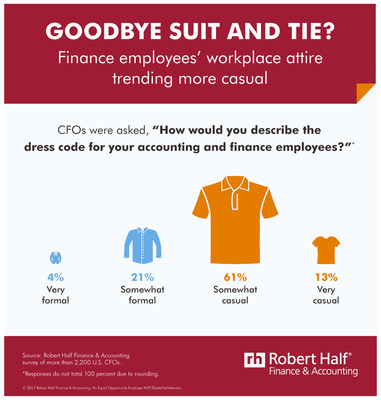Firm Management
Goodbye Casual Friday: Almost Every Day Is Becoming Casual
Don't expect your accountant to be sporting a tie or business suit. Workplace attire today is trending casual, even for historically more buttoned-up accounting and finance professions.
Jun. 19, 2017

Don’t expect your accountant to be sporting a tie or business suit. Workplace attire today is trending casual, even for historically more buttoned-up accounting and finance professions.
In a recent survey by recruitment firm Robert Half Finance & Accounting, 74 percent of CFOs said their accounting and finance departments have a somewhat or very casual dress code. Nearly one-quarter (23 percent) said business attire guidelines have relaxed over the last five years, compared to 16 percent who reported a more formal dress environment.
CFOs were asked, “How would you describe the dress code for your accounting and finance employees?” Their responses:
|
Very formal (suit and tie) |
4% |
|
Somewhat formal (dress slacks or skirt with button-down shirt) |
21% |
|
Somewhat casual (khakis and polo shirt or sweater) |
61% |
|
Very casual (jeans and T-shirt) |
13% |
|
99%* |
|
* Responses do not total 100 percent due to rounding. |
View an infographic of the survey findings.
“Workplaces are evolving and so are office attire trends,” said Robert Half senior executive director Paul McDonald. “Employees often prefer more relaxed attire, and having a casual dress code can be an enticement when recruiting finance and accounting professionals.”
Relaxing dress codes aren’t an excuse for employees and job seekers to wear whatever they want to work or an interview. Robert Half offers tips for dressing appropriately in today’s business environment:
- Look to the next rung. What does your boss — and your boss’s boss — wear? Take inspiration from upper management’s style and formality. Set yourself up for success by dressing for the job you want.
- Keep it tidy. Even if you can wear jeans and T-shirts to work, ensure they’re clean and wrinkle-free.
- Don’t forget the details. A dress code encompasses an employee’s total appearance. Pay as much attention to your accessories and grooming as you do your clothing.
- Play it safe when meeting with hiring managers. Don’t risk making a poor first impression with clothes that are too casual. Women should wear a blazer or business-appropriate dress and closed-toe shoes with a low heel. Men fare best in a suit or jacket and tie.
- Dress for your day. Some companies now give employees the flexibility to choose attire based on their responsibilities (e.g., visiting clients versus doing desk work). If you’re unclear of your organization’s guidelines, consult the employee handbook or human resources department. Consider keeping a jacket in your office should your day unexpectedly change.
McDonald offered a few additional tips: “For employees, if you’re not sure what’s appropriate to wear for a particular situation, talk to your manager. For job seekers preparing for interviews, tap your network or check out the employers’ social media activity for insights on the company’s corporate culture. If you’re still uncertain of what to wear, err on the formal side.”
The survey was developed by Robert Half Finance & Accounting and conducted by an independent research firm. It is based on telephone interviews with more than 2,200 CFOs from a stratified random sample of companies in more than 20 of the largest U.S. metropolitan areas.
